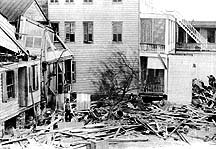1893 Sea Islands hurricane
| Category 3 major hurricane (SSHWS/NWS) | |

Damaged houses in Beaufort, South Carolina
|
|
| Formed | August 15, 1893 |
|---|---|
| Dissipated | September 2, 1893 |
| Highest winds |
1-minute sustained: 120 mph (195 km/h) |
| Lowest pressure | 954 mbar (hPa); 28.17 inHg |
| Fatalities | 1000-2000 |
| Damage | $1 million (1893 USD) |
| Areas affected | Georgia, South Carolina |
| Part of the 1893 Atlantic hurricane season | |
On August 27, 1893, a major hurricane which came to be known as the Sea Islands Hurricane struck the United States near Savannah, Georgia. It was one of three deadly hurricanes during the 1893 Atlantic hurricane season; the storm killed an estimated 1,000–2,000 people, mostly from storm surge. This is also the storm that made famous United States Life-Saving Service Keeper Dunbar Davis.
Modern analysis of historical records has allowed the history of this storm to be pieced together, although the analysis is only an estimate since few accurate meteorological records were taken.
On August 15, 1893, a tropical storm formed east of Cape Verde. It likely passed directly through the islands on the 16th, leaving their vicinity during the evening of the 17th. It became a hurricane on the 19th, while crossing the Atlantic between the Cape Verde Islands and the Lesser Antilles. The hurricane continued to strengthen, attaining Category 3 status on August 22 while located northeast of the Lesser Antilles. By the evening of the 25th, the storm was approaching the Bahamas. During the approach it began to deviate from its westerly course and arc west-northwest. It is believed that the first effects of the storm were beginning to be felt in the Sea Islands area, with the winds steadily increasing during the night of the 25th.
Some of the inhabitants anticipated the storm and left the islands as quickly as possible. The conditions soon rapidly deteriorated on the island and the hurricane passed over sometime on the 26th. By now the hurricane was turning more and more towards the north. It moved parallel to the coast for about one hundred miles before making landfall.
Landfall occurred near Savannah, Georgia, on August 27. Reports from the time say that wind during landfall was around 120 mph (190 km/h), making it a category 3 storm. Pressure in Savannah was measured at 960 mbar (28 inHg); modern estimates put the pressure around 954 mbar (28.2 inHg) at landfall, and possibly as low as 931 mbar (27.5 inHg) out at sea. This would have made the hurricane most likely stronger than a Category 3 storm on the Saffir–Simpson Hurricane Scale. The hurricane passed north over South Carolina on August 28 and moved up the U.S. East Coast before becoming extratropical over Atlantic Canada.
...
Wikipedia
